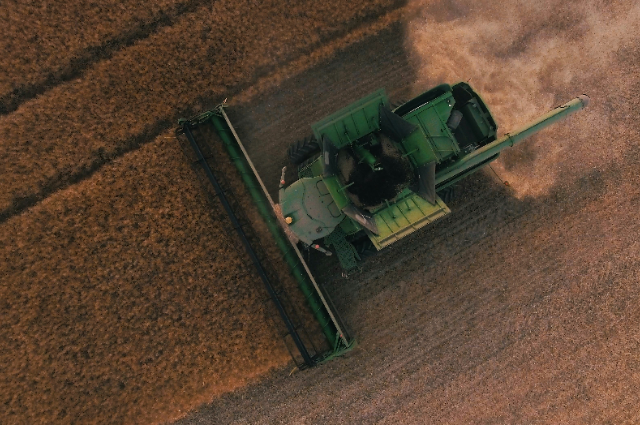
Photo by Tomas Hertogh on Unsplash
Tractors in India, on average, contribute to 7.4 percent of the country's total diesel consumption. They are responsible for 14 percent of India’s total Greenhouse gas emissions. There is an urgent need to replace these tractors and move to a low-carbon, sustainable economy. Electric tractors that harness renewable energy and reduce dependence on fossil fuels seem to be a promising alternative.
Farmers in most states of India receive subsidised electricity as part of a supply-side intervention. It helps them increase farm produce and boost livelihoods. The subsidised electricity reduces the operational cost of e-tractors and makes them a cost-effective option once purchased. E-tractors also have lower maintenance costs. It offers cost-saving benefits as it requires less maintenance since it is made of fewer parts. Less capital goes into maintaining it.
One might expect mass adoption of E-tractors considering they offer lower operational and maintenance (O&M) costs compared to diesel tractors. However, a different story unfolds. Even in areas with subsidised electricity, e-tractors are yet to be welcomed wholeheartedly. Farmers see more greenery and less pollution around them and are asking them to shift to e-tractors, stating climate change is tough. Alongside this, certain other restraints on this widespread adoption also exist.
Challenges Associated with the Widespread Adoption of E-tractors
The most visible challenge is the high upfront cost of e-tractors. The higher upfront cost is due to electric motors and battery technology expenses. India has a price-sensitive market, and this cost is sometimes beyond the purchasing power of farmers.
The perceived low horsepower of e-tractors and concerns about compatibility with various soils, crops, and terrains create a psychological barrier. Diesel tractors provide high horsepower and offer a wide range to choose from, ranging from 10 to 120 HP. In contrast, electric tractors range from 11 to 55 HP, leaving commercial farmers with fewer choices. Farmers, often deeply connected to the land, fear that e-tractors might not seamlessly integrate into their established farming practices.
A significant gap between interest and product availability exists. There are fewer players in the e-tractor market. That makes the e-tractor less competitive and prevents the upfront cost from coming down. This limited market competition leaves farmers with few brands to choose from and keeps the price of e-tractors high.
Some farmers think that there are additional costs involved in the setting up of e-tractors, like electrical upgrades. Many are worried that electric tractors can work on the farm as efficiently as diesel tractors. Tractors have long working hours and that necessitates large batteries and this is also one of the identified challenges.
India is aiming to provide 24x7 electricity to its population, but establishing charging infrastructure in villages is a massive task. Farmers also wonder if e-tractors can survive extreme working conditions. Heat, cold, and rainfall may be detrimental to the functioning of power electronics components.
Some farmers are worried about the performance of e-tractors during power outages. With power outages, farmers go days without electricity, and they fear that they might not continue to work in these conditions with their uncharged e-tractors.
Resale value poses challenges too. e-tractors have less resale value because batteries need replacement. E-tractors are a relatively new technology in its nascent stages. Farmers rightfully fear the lack of repair shops, and some even express concerns about not knowing how to operate e-tractors.
Total cost of ownership
E-tractors could be cost-competitive if incentives are provided. A working paper by ICCT presented a ten-year cost of ownership (TCO) analysis comparing electric and diesel agricultural tractors. The TCO of the e-tractor was ₹31.1 lakh, while that of the diesel version was less than ₹30.2 lakh. The analysis suggested that despite higher purchase costs for e-tractors, the cost gap over ten years is minor, even when assuming electricity and opportunity costs are at the upper bound.
Creating Battery Swapping Model for e-tractors
Kunal Khattar, Board Observer in battery maker Exponent Energy, made recommendations to fix the supply-side gap. Khattar highlighted an important mindset barrier when buying an e-tractor. He pointed out that when manufacturers purchase a diesel tractor, they don't ask for five years of fuel upfront. This is in contrast to the scenario with the battery cost of an e-tractor. If you remove the battery cost, the e-tractor price will be the same as the diesel one.
He also advised selling batteries and e-tractors separately. He suggested creating a battery-swapping model where farmers can rent and return batteries after use.
Tractors are not just another piece of machinery for farmers. Beyond their practical uses, they also hold immense symbolic purposes. Tractors are ingrained in the agricultural way of life and are reliable companions in the field. Increasing market competitiveness, providing incentives, and enhancing charging infrastructure, are essential for promoting widespread acceptance. Recognising the long-term cost competitiveness, coupled with targeted interventions, can pave the way for better adoption of e-tractors.
. . .
References:
- https://tractorkarvan.com/blog
- https://cuts-ccier.org/promoting-e-tractor
- https://www.researchgate.net/publication
- https://planet.outlookindia.com/news
- https://theicct.org/indias-electric-tractors-nov22
- https://inc42.com/resources
- https://cuts-ccier.org
- https://tractorgyan.com/tractor
- https://tractorkarvan.com/electric-tractors
- https://www.fnfresearch.com/electric-tractor-market
- https://ijirt.org/Article?manuscript=150773
- https://theicct.org/wp-content/uploads
- https://the-ken.com/story/giants
- https://economictimes.indiatimes.com
